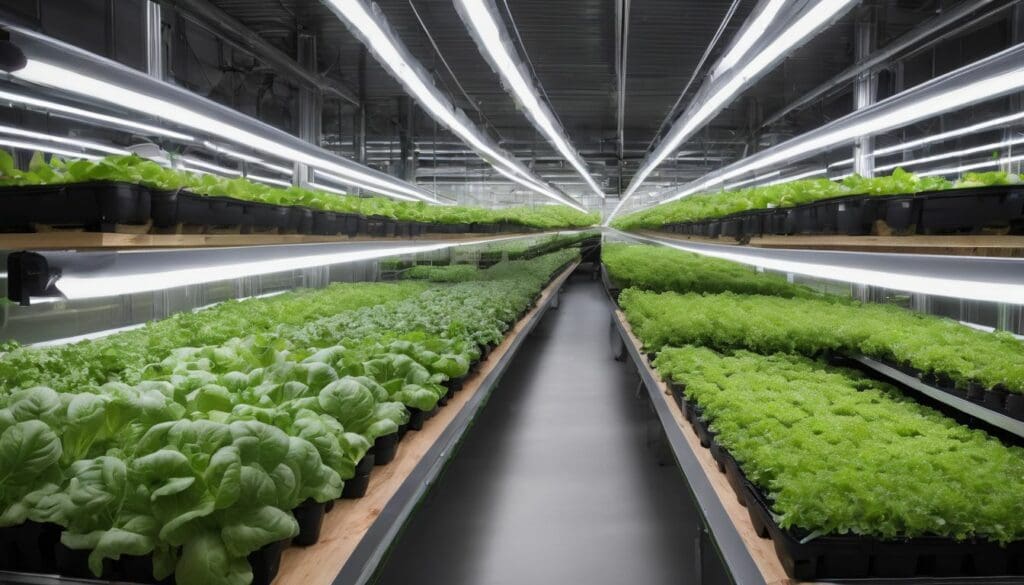As our world continues to expand at a breakneck pace, the quest for innovative and sustainable methods of food production becomes ever more pressing. We’re not strangers to this challenge either; indeed, vertical farming has captured our collective imagination as a potentially game-changing solution.
With projections tipping it to burgeon into a whopping $24.8 billion market by 2026, it’s impossible not to feel a flutter of excitement at the prospect. In today’s discussion, we’ll delicately peel back the layers on how transforming towering structures into verdant farmlands could hold the key to nourishing our urban populations of tomorrow.
Join us on this enlightening journey through gardens in the clouds!
Key Takeaways
- Vertical farming is an innovative method that grows crops in stacked layers, using technologies like hydroponics to produce food year-round without soil or traditional land.
- This approach to agriculture could become a $24.8 billion market by 2026, offering higher yields in smaller spaces and employing energy-efficient practices such as LED lighting and water recycling systems.
- By minimising the impact of weather conditions and reducing land use, vertical farming offers a sustainable solution for urban areas facing space constraints and seeks to lower transportation emissions.
- As cities grow, integrating vertical farms within urban planning can enhance access to fresh produce, create jobs, and support economic growth in local communities while promoting environmental sustainability.
- Although initial setup costs are high for vertical farms, continued technological advancements are expected to reduce these expenses over time, making it more viable for wider adoption.
Defining Vertical Farming
Vertical farming is the practice of growing crops in vertically stacked layers, often in controlled environments like warehouses or skyscrapers. This innovative method differs from traditional farming as it utilises advanced technologies such as hydroponics and aquaponics to efficiently produce a variety of crops year-round without the need for extensive land.
Difference from traditional farming
We see vertical farming as a game-changer compared to traditional farming methods. Instead of spreading outwards across vast fields, we reach for the sky by stacking crop layers in indoor environments.
Our plants thrive without soil, receiving nutrients from solutions like hydroponics and aquaponics. We meticulously control light, temperature, and humidity to grow food with precision.
This farming approach isn’t bound by seasonal changes or weather conditions; it guarantees year-round production.
Our practices steer clear of heavy machinery that compacts soil and leads to erosion over time. Pests and diseases are fewer indoors, cutting down on the need for harmful pesticides which benefits both our health and the environment’s well-being.
Next up, let’s dive into the numerous benefits that vertical farming brings to our table – quite literally!
Benefits of vertical farming
- Vertical farming maximises the use of vertical space, allowing for higher crop yields in a smaller footprint compared to traditional farming methods.
- It reduces the need for extensive land use, making it an ideal solution for urban areas with limited space and opening up opportunities for sustainable agricultural practices in densely populated regions.
- Vertical farming systems utilise advanced water and nutrient – use efficiencies to minimise resource consumption, contributing to environmental sustainability and efficient agricultural practices.
- These indoor farming techniques provide a controlled environment that minimises the impact of weather conditions, pests, and diseases on crop production, ensuring consistent and reliable food supply.
- Vertical farming allows for year – round cultivation, overcoming seasonal limitations and increasing the availability of fresh produce regardless of external factors such as climate or geographical location.
The Impact of Vertical Farming on the Environment
Vertical farming has a significant impact on the environment by reducing land use, conserving water, and increasing energy efficiency. This innovative approach to agriculture offers a sustainable solution for future food production.
Reduced land use
Vertical farming significantly reduces land use compared to traditional agriculture. This method maximises the use of vertical space, allowing crops to be grown in stacked layers indoors.
By utilising this technique, vertical farming optimises the available land and minimises the need for large expanses of agricultural fields. This approach is crucial for sustainable food production as it helps conserve valuable land resources while meeting increasing demands for fresh produce.
In addition to reducing land use, vertical farming also presents an opportunity to cultivate crops in urban areas where arable land is limited. The efficient utilisation of vertical space enables food production closer to consumers, contributing to local food security and reducing the environmental impact associated with transportation and distribution.
With reduced reliance on expansive farmland, vertical farming offers a promising solution for addressing future challenges related to food production and resource efficiency.
Water conservation
Indoor farming systems in vertical farms maximise water efficiency by using techniques like hydroponics and aeroponics. These methods significantly reduce water usage compared to traditional agriculture, making vertical farming a sustainable solution for food production.
With the capability to recycle and reuse water within the closed environment of indoor farms, this cultivation method helps mitigate the strain on freshwater resources.
Additionally, vertical farming’s controlled environment allows for precise monitoring of water usage and prevents wastage through runoff or evaporation. By employing innovative irrigation technologies tailored to specific crop needs, such as drip systems and foggers, vertical farms further optimise water conservation efforts while ensuring high yields of fresh produce.
Energy efficiency
Vertical farming maximises energy efficiency by utilising advanced lighting and climate control systems, ensuring that crops receive the right amount of light, temperature, and humidity to thrive.
LED lights are used to provide optimal conditions for plant growth while consuming less energy than traditional lighting methods. By carefully regulating environmental factors within the indoor farming environment, vertical farms can minimise energy wastage and reduce overall operational costs.
Efficient use of water is another key factor contributing to the sustainability of vertical farming. Hydroponic and aquaponic systems allow plants to grow without soil, using only a fraction of the water required in traditional agriculture.
The Economic Benefits of Vertical Farming
Vertical farming offers significant economic benefits, including increased food production, job creation, and the potential for growth in urban areas. It has the ability to revolutionise agriculture and provide sustainable solutions for future generations.
Increased food production
Vertical farming revolutionises food production by maximising the use of vertical space indoors. With crops grown in stacked layers using innovative techniques such as hydroponics and aquaponics, this approach significantly increases yield per square metre.
The efficient use of water and nutrients maximises crop health and productivity, contributing to sustainable food production on a larger scale. This method allows for more food to be grown in urban areas, offering fresh produce closer to consumers while reducing the environmental impact of traditional agriculture.
Furthermore, vertical farming’s ability to grow crops at any location makes it a valuable solution for meeting increasing global food demand. By utilising technology that optimises growing conditions, vertical farming is poised to play a significant role in providing healthy and sustainable local produce while addressing challenges related to land and water constraints in agricultural practices.
Job creation
Vertical farming has the potential to create new job opportunities in urban areas, contributing to the growth of sustainable agriculture. As this innovative industry continues to expand, it will require a skilled workforce for roles such as crop technicians, vertical farming system designers, and agricultural technology specialists.
According to industry reports, the market value of vertical farming is estimated to reach $24.8 billion by 2026, indicating significant potential for job creation within this sector.
With its focus on efficient land use and sustainable food production practices, vertical farming offers an exciting prospect for individuals interested in pursuing careers that align with environmental stewardship and technological innovation.
Growth potential in urban areas
Urban areas offer a promising landscape for the growth of vertical farming. With increasing populations and limited arable land, the expansion of urban agriculture is vital. This form of agriculture can bring food production closer to consumers, providing opportunities for job creation and sustainable economic growth within cities.
Vertical farming’s ability to efficiently maximise space aligns with the compact nature of urban environments, making it a compelling solution for meeting growing food demands in densely populated areas.
Furthermore, by integrating vertical farming with urban planning, fresh produce can be readily accessible to city dwellers while reducing transportation emissions. The potential impact on creating climate-resilient agricultural systems makes vertical farming a key player in building sustainable and resilient future cities.
Challenges and Solutions for Vertical Farming
The initial costs of setting up a vertical farm can be a challenge, but technological advancements and sustainable business models are providing solutions to make it more viable. To learn more about how vertical farming is revolutionising food production, keep reading!
Initial costs
Initial costs for vertical farming can be substantial, primarily due to the need for high-tech equipment and infrastructure. Investing in efficient lighting systems, hydroponic or aquaponic setups, and climate control technology is crucial.
However, as the industry continues to grow rapidly, the initial expenses are decreasing due to increased competition and advancements in technology. Start-up costs could also be offset by government grants and incentives aimed at promoting sustainable agricultural practices.
Setting up a vertical farm requires careful financial planning, but with potential long-term benefits such as reduced water usage and energy efficiency coming into play, it’s an investment that holds promise for sustainable food production.
Technological advancements
- Automated Growing Systems: Advanced robotics and automation technologies enable precise monitoring and automated control of environmental conditions such as light, temperature, and humidity.
- LED Lighting: Energy-efficient LED lights provide specific light spectra tailored to different plant growth stages, optimising photosynthesis and enhancing crop yields.
- Data Analytics: Utilising big data analytics and machine learning algorithms to optimise crop production, resource usage, and predictive maintenance in indoor farming systems.
- Vertical Farming Software: Innovative software solutions allow farmers to monitor and manage crop growth remotely, adjusting growing parameters in real-time for optimal productivity.
- Vertical Hydroponic Systems: High-tech hydroponic systems maximise water efficiency by delivering precise nutrient solutions directly to plant roots grown in vertical layers.
Sustainable business models
- Vertical farming promotes resource efficiency by maximising the use of vertical space, reducing land use, and conserving water.
- Sustainable indoor farming systems utilise innovative techniques such as hydroponics and aquaponics to achieve high water- and nutrient-use efficiencies, reducing operational costs and environmental impact.
- The integration of technology, such as smart sensors and data analytics, enhances crop management and reduces resource wastage, contributing to a more sustainable and cost-effective business model.
- Urban vertical farms create job opportunities within local communities, supporting economic growth and fostering a sense of environmental responsibility among urban residents.
- By providing fresh produce directly to urban areas, vertical farming reduces transportation emissions and promotes a circular economy, contributing to the overall sustainability of food supply chains.
- Through strategic partnerships with local businesses and educational institutions, vertical farms can establish community-supported agriculture programmes, enhancing social responsibility while ensuring a consistent market for their produce.
- Sustainable business models in vertical farming support climate – resilient agriculture practices, contributing to global food security by adapting to changing environmental conditions while minimising environmental impact.
The Future of Vertical Farming
Vertical farming holds immense potential to meet the increasing demand for food in an urbanising world. Integrating vertical farming with urban planning could revolutionise access to fresh produce and shape the future of sustainable agriculture.
Potential to meet increasing food demand
Vertical farming offers the potential to significantly increase food production to meet the growing demand for fresh produce. With its ability to grow crops efficiently at any location, this innovative method addresses the need for sustainable agriculture while also contributing to food security.
By maximising vertical space and utilising advanced techniques such as hydroponics and aquaponics, vertical farming is poised to play a crucial role in meeting the increasing demands for healthy and locally sourced produce.
As urban areas continue to expand, integrating vertical farming into urban planning can further enhance access to fresh food while mitigating environmental impact.
Integration with urban planning
To ensure the success of vertical farming, it is essential to integrate with urban planning. By incorporating vertical farming into city development, we can address food security challenges while mitigating the environmental impact of transporting produce over long distances.
Urban planners can strategically allocate space for vertical farms within cities, promoting accessibility to fresh and locally grown produce for urban populations. This integration not only supports sustainable agriculture but also contributes to creating climate-resilient and self-sufficient urban communities by reducing the carbon footprint associated with food production and distribution.
Integrating vertical farming with urban planning aligns with our aim to cultivate a more sustainable future. As cities continue to expand, integrating indoor crop cultivation into urban landscapes offers an innovative solution for meeting the increasing food demand in densely populated areas.
Expanding access to fresh produce
Vertical farming plays a pivotal role in expanding access to fresh produce by reducing the distance between farms and urban consumers. This innovative approach enables crops to be grown closer to where people live, decreasing transportation costs and environmental impact.
Additionally, vertical farming provides the opportunity for urban communities to have direct access to locally grown, organic fruits, vegetables, and herbs all year round—ensuring a sustainable and consistent supply of fresh produce for local markets.
Furthermore, vertical farming addresses food deserts in urban areas by bridging the gap between food production and consumption. By strategically locating indoor farms within city limits, this agricultural innovation helps ensure that everyone has convenient access to nutritious and affordable fresh produce.
As technology continues to advance in controlled environment agriculture, vertical farming is set to revolutionise how we source our food – transforming cities into self-sufficient hubs of agricultural abundance.
Conclusion
In conclusion, vertical farming holds the promise of revolutionising crop production and ensuring a more sustainable future. The benefits include increased food production, reduced land use, and water conservation.
This innovative approach also offers economic opportunities and the potential for urban expansion. With technological advancements and growing market value, vertical farming is poised to play a pivotal role in shaping the future of agriculture.
FAQs
1. What is vertical farming and how does it relate to sustainable development?
Vertical farming is a method of growing crops indoors on stacked layers, which saves space and contributes to sustainable development by using fewer resources.
2. Can vertical farming be done in cities?
Yes, urban farming techniques like hydroponic and aquaponic systems make it possible for vertical farms to thrive right in the heart of cities.
3. How does vertical farming help with climate-resilient agriculture?
By controlling the environment indoors, vertical farms are less affected by unpredictable weather, making crop production more reliable and climate-resilient.
4. Is the future of farming moving towards indoor methods like vertical farming?
Many experts believe that as we face global challenges such as population growth and climate change, indoor methods like vertical farming will become crucial for food sustainability.





